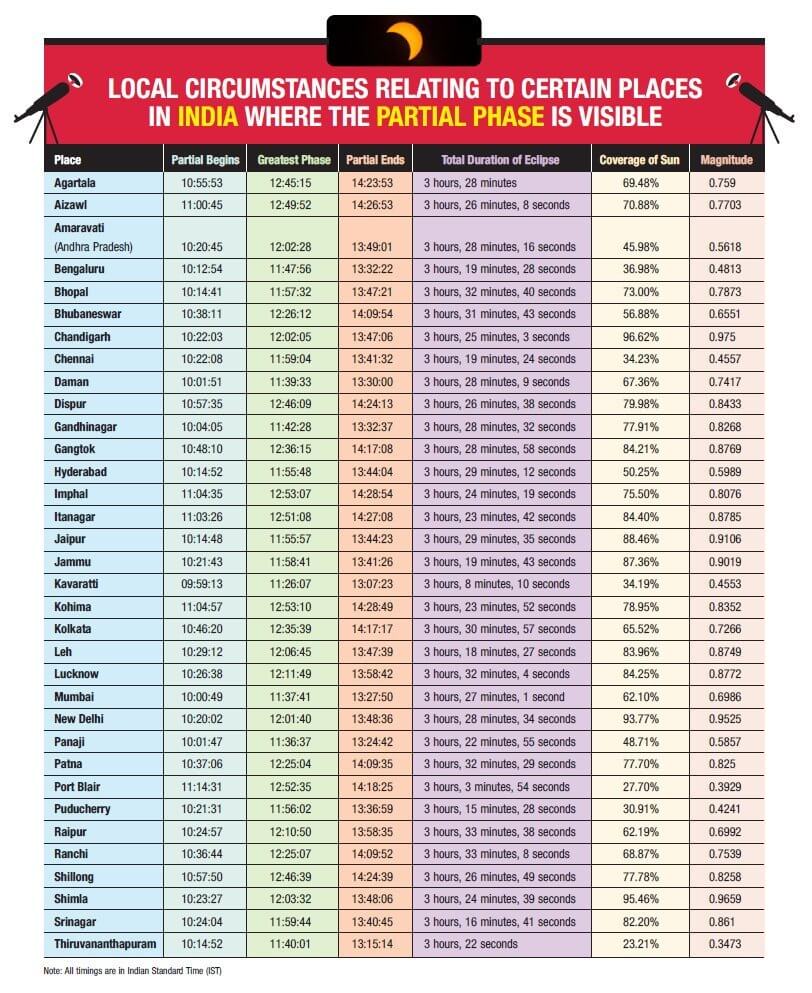On 21 June 2020, 12 countries across the world are witnessing rare celestial event, annular solar eclipse, popularly called as ring of fire eclipse. The first 2020 solar eclipse is taking place on the summer solstice (21 June), which is the longest day in the Northern Hemisphere.
While people living along the path annular eclipse passing through Anupgarh, Suratgarh, Sirsa, Jakhal, Kurukshetra, Yamunanagar, Dehradun, Tapowan and Joshimath will be able to see the annular phase, people in rest of India can witness a partial eclipse.
Solar Eclipse & Annular Solar Eclipse
A solar eclipse occurs when the Moon passes between Earth and the Sun, thereby totally or partly obscuring the image of the Sun for a viewer on Earth. Thus, the moon blocks the light of the sun from reaching Earth. This causes an eclipse of the sun, or solar eclipse. During a solar eclipse, the moon casts a shadow onto Earth.


Types of Solar Eclipse:
Based on the alignment, there are three kinds of solar eclipses — total, partial, and annular — along with the addition of a rare hybrid of an annular and a total solar eclipse.
Total Solar Eclipse:
A total solar eclipse is only visible from a small area on Earth. The people who see the total eclipse are in the center of the moon’s shadow when it hits Earth. The sky becomes very dark, as if it were night. For a total eclipse to take place, the sun, moon and Earth must be in a direct line.
Partial Solar Eclipse:
The second type of solar eclipse is a partial solar eclipse. This happens when the sun, moon and Earth are not exactly lined up. The sun appears to have a dark shadow on only a small part of its surface.
Annular Solar Eclipse:
The third type is an annular solar eclipse. An annular eclipse happens when the moon is farthest from Earth. Because the moon is farther away from Earth, it seems smaller. Hence, the apparent diameter of moon is smaller. As a result, it does not block the entire view of the sun. The moon in front of the sun looks like a dark disk on top of a larger sun-colored disk. This creates what looks like an annulus (a ring) around the moon.
Solar eclipses happen once every 18 months. Unlike lunar eclipses, solar eclipses only last for a few minutes.
Shadows of the Moon
During a solar eclipse, the moon casts two shadows on Earth. The first shadow is called the umbra. This shadow gets smaller as it reaches Earth. It is the dark center of the moon’s shadow.
The second shadow is called the penumbra. The penumbra gets larger as it reaches Earth. People standing in the penumbra will see a partial eclipse. People standing in the umbra will see a total eclipse.

2020 Solar Eclipse
The June 21 eclipse will be visible from much of Asia, Africa, the Pacific, the Indian Ocean, parts of Europe and Australia. Today is the first solar eclipse of 2020. The second and last solar eclipse of the year will take place on December 14, 2020.
2020 Solar Eclipse in India
Today the annual solar eclipse will start at 9:15 AM IST and will be visible until 3:04 PM IST. The maximum eclipse will take place at 12:10 IST.
According to Nehru Planetarium, Bhuj will be the first city in India from where the beginning of the eclipse will be visible at 9.58 am. The eclipse will end four hours later at 2.29 pm. The ring of fire will not be seen constantly. It will only be seen when the eclipse is at its peak. Before and after that you will only be able to see a crescent shape Sun.
The 21 June 2020 solar eclipse will be the last solar eclipse to be seen from India for the next 28 months. The next solar eclipse that will be visible from India will take place on October 25, 2022.

How to watch Solar Eclipse
Looking at the Sun directly can cause permanent damage to the retina so it is recommended to use special goggles, welder’s shield, or pin-hole imaging technique to see the solar eclipse. Do not use sunglasses, goggles, exposed x-ray sheet or lampblack over a glass. They are not safe. Nor is viewing the Sun’s image on the surface of the water.


How to watch solar eclipse online
You can watch live feed of 2020 solar eclipse along with discussions with scientist live of Doordarshan Channel



